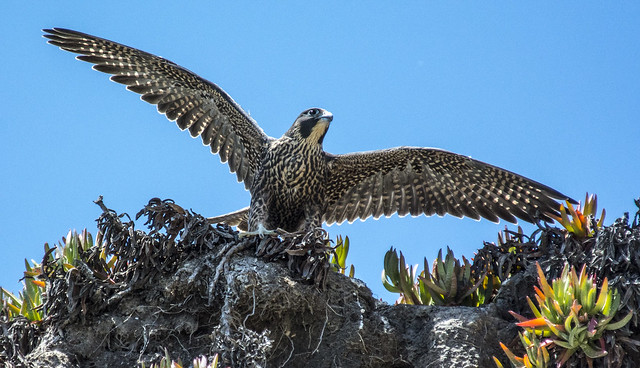 |
| Photo by jkirkhart35 |
This creature is one of the most powerful and fast-flying bird there is. The Peregrine Falcon probably has one of the longest migrations of any bird in North America. Covering as much as 15,500 miles in one year over two different continents, spanning North and South America, hence the meaning of the falcon's name, "wanderer" or the scientific name of "Falco pereginus."
This is an incredible flier! You will find that these Falcons are averaging 25-34 miles per hour in traveling flight and as fast as 69 miles per hour in direct pursuit of prey with a hunting stoop from heights of over .62 miles! I don't even know if a Geo Spectrum could cruise at that speed. After reaching speeds of 200 miles per hour, they will drop toward their prey and kill it by biting into the neck of a passing songbird, duck and occasionally bats. OUCH!!! These falcons are so acrobatic, they can even catch their prey in mid-air. What a feat!!!
The Peregrine Falcon's habitat is comprised of every continent in the world save Antarctica and on many oceanic islands making them one of the most widely distributed species in the world. What proof is there that shows the durability of this bird? It has been proven that the falcon can survive in a wide range of areas of habitat to include: urban cities, deserts, the tundra and the tropics. They remind me of people who live in the state of Maine and then travel to Florida in the winter because the Peregrine Falcon will migrate super long distances from where they reside in the winter, to their summer nesting areas on the globe. Who knows? They may have even bought into "Time Shares."
Have you ever been in a big city and see an image of a hawk or eagle on a skyscraper? There is a stark parallel to real habits of these falcons that are illustrated high atop those buildings. For instance, Peregrine Falcons have done a great job in adapting to living in many of our cities in the United States of America. They have the ingenuity to make use of tall skyscrapers and buildings that have suitable ledges for nesting. They display their desire for cuisine variety in their meals by making use of their neighbors, the pigeon, and starlings, in the cities for their food supply. What a tasty and scrumptious treat for these Teflon birds.
These Peregrine Falcons are very intelligent and trainable also. This has always been one of the most prized birds amongst men. People have used and trained these birds for hunting, as well as message carriers. In 1940, the Federal Government issued an order to cull these Peregrine Falcons bringing about the death of 600 birds. One reason may have been because in the second World War, the armed forces used over 200,000 homing pigeons as message carriers which were also on the menu of these falcons. This was part of the reason for the decline in these fabulous birds. Populations began a rapid decline from 1950 - the 1970's because of DDT (Dichloro-diphenyl-trichlorethane) poisoning. This poisoning effected The Peregrine Falcon eggs, causing thinning and making them susceptible to breakage during incubation. Not to mention other birds of prey such as the Golden Eagle and the Great-horned owl would occasionally kill peregrine falcon chicks. At this point, they made the Endangered Species list and by 1970 extensive efforts were made to reestablish the birds' population. Man driven efforts to breed the Peregrine in captivity began to make a difference to this almost "down for the count" bird. This is why we consider them the "Teflon" bird of prey. They have made an awesome come back. By 1999, the peregrine falcon finally made it off the Endangered Species list.
As we have seen in part, with the aide of man the peregrine falcon almost became extinct and with the aide of man the peregrine falcon has made a tremendous comeback. Let us all be aware and continue to be part of the solution in taking part in the preservation of this "Teflon" survivor. Watch them soar, watch them hunt, watch them perch in their natural habitats. The history of this falcon is one you can share with your children and grandchildren for ages to come.
Gary Freeman. I am a wildlife enthusiast living in Wyoming. I want to get the word out about wildlife preservation and natural insect control. [https://www.wildlife-houses.com/] - http://wildlife-houses.blogspot.com/
Article Source: EzineArticles
|

No comments:
Post a Comment